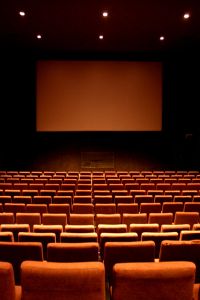[ad_1]
Contributed by Debbie Clason, staff writer, Healthy Hearing
Although the Americans with Disabilities Act (ADA) made accessibility mandatory, it’s modern technology that has made it possible for the deaf and hearing impaired to enjoy a night at the movies. Today, companies like Sony are partnering with movie theaters to create true multi-media experiences for those who cannot hear. And, although new technology isn’t available in all movie theaters just yet, most comply with federal regulations requiring them to provide hearing assistive services for their hearing impaired customers.
Closed captioning
Most of us are familiar with closed captioning. In 1993, the Federal Communications Commission (FCC) required television manufacturers to provide closed captioning capabilities. The technique allows the viewer to see text of audio programming displayed on their television screen.
In 1996, the National Association of the Deaf (NAD) established the Movie Access Coalition (now known as the Coalition for Movie Captioning) to encourage movie theaters to do the same. Although new caption display technology has eliminated the cost of producing caption film prints, the NAD says only 1 percent of movies being shown today are shown with captions.

other assistive listening devices!
Subtitle glasses
Sony has personalized the closed-captioning concept with the invention of their Entertainment Access glasses. Instead of reading captions on the screen in front of them, these glasses project captions in the air in front of the viewer. The text can only be seen by the user; glasses are large enough to fit over conventional eyeglasses.
Theaters began offering this technology to its customers in 2013. Regal Entertainment Group provides these glasses in 6,000 of its movie theaters. Other theaters offering this technology in select locations include Muvico Theaters, Carmike Cinemas, Water Gardens Theaters, BAM Rose Cinemas, Drexel Theaters, and Fridley Theaters.
Rear-window captioning
If Entertainment Access glasses aren’t available in your local theater, you may be able to take advantage of rear-window captioning. With this technology, patrons view text on a personal panel which displays captioning reflected from an LED screen at the back of the theater. The panel is mounted on a flexible plastic stalk which fits in the cup holder. It may be necessary to sit in a special section of the theater in order to get the best angle.
AMC theaters provide this service in approximately 160 locations throughout the country. A list of theaters equipped with this service can be found on the Motion Picture Access website.
Smart phone applications
Want to attend a movie at a theater that doesn’t offer closed captioning? Believe it or not, there’s an app for that. If you have a smart phone, you may be able to download an application that will provide subtitles and/or captioning for you.
Subtitles Viewer, a free application for the iPhone, offers subtitles for a large library of new releases and old favorites in 20 different languages. Because movie theaters often have a “no cell phone” policy, you may want to check with them before using this feature.
When you’re looking for a movie theater near you which offers closed-captioning, rear-window captioning or other subtitled and descriptively captioned movies, check with Captionfish. The free app for Apple users and website, developed by three deaf developers, uses zip-code locating to find a US movie theater closest to you.
Assistive listening device (ALD) systems
Even if your local theater doesn’t have the newest captioning technology, they most likely offer some type of assistive listening device system for individuals with some residual hearing. Since the enactment of the ADA in 1990, all theaters with fixed seating for 50 patrons are required to provide an ALD system.
Three different systems may be available:
- FM systems use radio frequencies to transmit amplified sound through a special receiver customers can borrow for the duration of the film.
- Infared Light systems transmit sound to a special receiver, which can be adjusted to the desired volume. When available, these receivers are loaned to the patron for the duration of the film.
- Induction Loop systems receive the sound signal through the t-coil in your hearing aid or cochlear implant. If your theater is wired for induction loops, you’ll want to switch your hearing instrument to t-coil to enjoy the show.
You can also check with your hearing healthcare professional to see if they can recommend the movie theater in town with the best access options for you. If your hearing impairment has been keeping you away from the movie theater, it may be time to venture out. With a little research and new technology, a night at the movies can be an enjoyable event for everyone in the family.
[ad_2]
Source link

